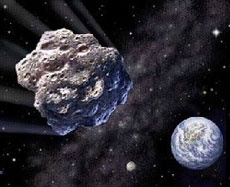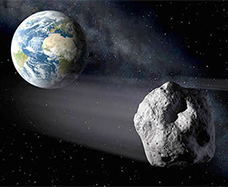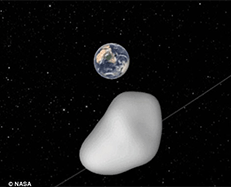The asteroid referenced as 2001 FO32 will pass close to the Earth on March 21 at 16:02 UTC (17:02 in French Legal Time). At this moment, the distance between the asteroid and the Earth will be 2 016 158 km, that is to say approximately 5.24 times the distance between the Earth and the Moon ; its speed with respect to the Earth will be 34.413 km/s, with the component of the speed orthogonal to the plane of the ecliptic equal to 13. 92 km/s : this "close" passage thus takes place between two objects of the Solar System which evolve in very inclined planes one with respect to the other (of the order of 40 degrees), and it is this inclination which makes this meeting with the Earth relatively infrequent.


This rocky body was observed for the first time on March 23, 2001 by the telescopes of New Mexico, which are part of the Lincoln Near-Earth Asteroid Research (LINEAR) program. Since this date, it is the object of a close surveillance with regular observations, which allowed to refine over time the calculation of the elements that characterize its trajectory.
It is an asteroid belonging to the family of near-Earth asteroids called "Apollo", which counts 12062 individuals on March 1, 2021 (IMCCE data : http://www.imcce.fr). The Apollo are characterized by a semi-major axis larger than the astronomical unit, and by a perihelion distance smaller than the aphelion of the Earth : the Apollons are the asteroids that go around the Sun in at least one year, and that can nevertheless cross the orbit of the Earth.

According to the definition of the International Astronomical Union (https://www.iau.org/public/themes/neo/nea2/), an asteroid is considered as a potentially hazardous asteroid (PHA) when its orbit is less than 0.05 astronomical units from the Earth (i.e. about 19.5 times the Earth-Moon distance), and has a diameter greater than 140 meters. With its estimated diameter between 540 and 1700 m (https://www.minorplanetcenter.net/iau/mpc.html), the asteroid 2001 FO32 is well within the category of potentially dangerous asteroids, and it is moreover the largest known object which approaches the Earth in 2021. Its trajectory being however sufficiently well known and regular, the experts of celestial mechanics of the Paris Observatory can guarantee with certainty that any risk of collision with the Earth is entirely ruled out.
Such close encounters are very frequent, mostly with smaller objects. Let’s mention for example the object 2021 FH, of a size of about ten meters, which will be on March 23 at 16:06 at 0.61 lunar distance (i.e. the distance between the Earth and the Moon), or the very numerous shooting stars which adorn the night skies and which are nothing else than very small asteroids which come to consult each other at the time of their re-entry in the atmosphere. As for the potentially dangerous asteroids, observation programs conducted by astronomers around the world track them relentlessly in order to draw up the most exhaustive inventory possible. The first (and largest) asteroid, Ceres, was discovered on January 1, 1801 ; the number of known asteroids in the Solar System was less than 10,000 in 1908 ; today it is more than one million.
The passage of 2001 FO32 on March 21, 2021 is a non-event because it does not present any risk, but reminds us that we must remain mobilized for the surveillance of our space environment.
Find these objects that have grazed the Earth through our news

|
February 15, 2013 Asteroid 2012 DA14 grazed the Earth |

|
October 31, 2015 October 31, 2015 : surprise visit from an asteroid !!!->art3304} |

|
April 19, 2017 April 19, 2017 : surprise visit from a large asteroid !->art3606 |

|
12 Oct 2017 Thursday, Oct 12, 2017, asteroid 2012 TC4 crosses Earth’s orbit |
Know more
To go further on the theme of asteroids, follow the scientific culture seminarof Antonella Barrucci, astronomer from Paris Observatory - PSL, on our YouTube channel.
Reference : J. Berthier et al., Miriade : A Service for Solar Sytem Ojects Ephemerides in the VO Framework, European Planetary Science Congress 2009
